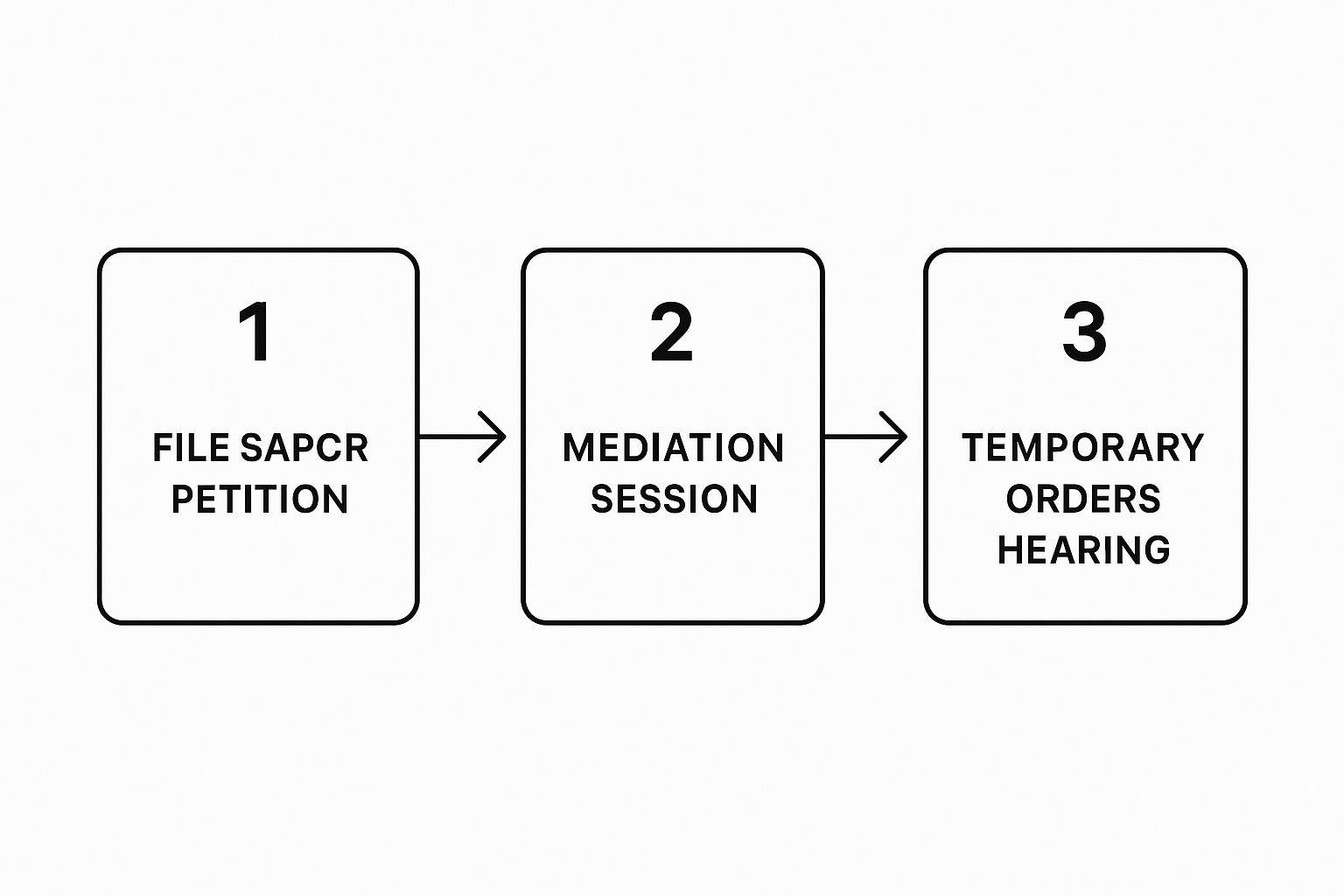When your relationship with your child is on the line, understanding your rights is the first step toward protecting that precious bond. It’s completely normal to feel worried and overwhelmed by the legal system, but Texas law is built on a foundation that encourages strong, ongoing relationships between children and both of their parents.
To get your rights legally protected, you need a court-approved Possession Order. This is the official document that outlines exactly when you have the right to have your child with you. The most common way to get one is by filing a Suit Affecting the Parent-Child Relationship (SAPCR), which is the formal legal process for establishing or changing custody, visitation, and child support under the Texas Family Code.
Throughout this process, remember the court's goal isn't to pick a "winner." It's to create a stable, loving environment that serves the best interests of your child.
Understanding Your Visitation Rights in Texas

Let's cut through the legal jargon. What most of us call "visitation," Texas law calls possession and access. The court order that maps out the visitation schedule is the Possession Order. Think of it as a legally binding calendar that sets the specific dates and times each parent has the right to have the child.
Understanding a few of these key terms will empower you to protect that bond with your child.
The Best Interest of the Child
Every single decision a Texas family court makes about a child circles back to one core principle: the “best interest of the child.” This isn't just a casual phrase; it's the legal standard a judge must use when creating orders for custody and possession, as outlined in Texas Family Code Chapter 153.
While there isn't a strict checklist, judges weigh several factors to determine what will best support a child’s emotional and physical well-being.
These often include:
- The child’s emotional and physical needs, both now and in the future.
- Any potential for emotional or physical danger.
- The parenting skills of each person seeking custody.
- How stable the proposed home environment is.
- The child's own wishes, if they're old enough to express them (usually age 12 or older).
This standard keeps the focus exactly where it should be—on creating a safe, stable, and loving environment for your child to thrive.
Conservatorship and Your Possession Schedule
In Texas, we don't legally use the term "custody." Instead, the law refers to it as conservatorship. In the vast majority of cases, a court will name both parents as Joint Managing Conservators. This means you both share the rights and duties of raising your child, like making decisions together about their schooling and healthcare.
A common misconception is that "Joint Managing Conservatorship" automatically means a 50/50 schedule. While parents share decision-making power, the court typically names one parent the "primary" conservator. This is the parent who establishes the child's main residence, and the possession schedule is built from there.
Your Possession Order is tied directly to your conservatorship status. It spells out the specific times the non-primary parent will have the child, covering everything from weekends and holidays to summer vacations.
Getting clear on your legal standing is the first step toward securing these vital visitation rights. This guide will walk you through the process, helping you establish a clear, enforceable schedule that protects your time with your child.
Who Can Request Visitation in Texas
When you're fighting for time with a child you love, the first question is often the most basic one: do I even have the right to ask? In Texas, the law provides clear answers, and it all boils down to established relationships and the child's well-being. Knowing where you stand is the absolute first step toward building a strong case.
The most direct path to securing visitation rights belongs to a child's legal parents. You're considered a legal parent if you are named on the child's birth certificate, have signed an Acknowledgment of Paternity, or have already been declared the parent by a court order.
And let's clear up a common and damaging myth right now: Texas family courts do not favor mothers over fathers. The law is explicitly gender-neutral. A father has the exact same legal standing as a mother to request possession of and access to his child. The court's decisions are based on actions, stability, and the ability to provide a safe home—not gender.
When Non-Parents Can Seek Visitation
But what if you aren't a legal parent? What if you're a grandparent, aunt, or another relative who has been a constant, loving presence in a child's life? Texas law recognizes that sometimes the most important caregivers aren't the parents. While non-parents don't have an automatic right to visitation, they can petition the court under very specific circumstances.
To have standing—which is the legal right to even file a lawsuit—a non-parent usually has to prove they've had "actual care, control, and possession of the child for at least six months."
For example, think about a grandmother who took in her grandchild for a year while the child's parent was dealing with a serious health crisis. During that time, she was the one enrolling the child in school, taking them to doctor's appointments, and being their primary caregiver day in and day out. That significant history gives her the legal standing to ask the court for a visitation order to keep that vital bond alive.
On top of that, the court must also find that denying visitation would significantly impair the child's physical health or emotional well-being. This is a high bar to clear, but it shows how committed the courts are to protecting the stable, nurturing relationships that are so critical to a child's development.
The Importance of a Formal Agreement
Whether you're a parent or a grandparent, relying on a handshake deal for visitation is a huge risk. Life changes. What works today might completely fall apart tomorrow, leaving you with no legal way to see the child. In the U.S., about 90% of custody and visitation cases get settled without a full-blown court trial, often through mediation.
But for that other 10% where agreements break down, having a formal court order is your only real protection. Securing a formal Possession Order ensures your time is legally protected, no matter how the other parent feels or what changes in their life. You can review the data on child custody case submissions here to see more on these trends.
At the end of the day, whether you're a mother, a father, or a loving grandparent, the legal system provides a path to secure your relationship with a child you care about. Understanding your specific standing is the crucial first step on that journey.
Navigating the Texas Legal Process
When you’re worried about your future with your child, the legal system can feel like a maze. But understanding the path ahead can turn that anxiety into a clear plan. The process for getting visitation rights in Texas is a series of structured steps, each one designed to bring your family toward a stable, court-ordered schedule.
It all begins with one critical document: filing a Petition in a Suit Affecting the Parent-Child Relationship (SAPCR). This is the formal paperwork that officially opens your case and tells the court who’s involved, what your relationship is to the child, and exactly what you’re asking for—in this case, a formal Possession Order that lays out your visitation rights.
Filing the Initial Lawsuit
Your SAPCR Petition is more than just a form—it's your first official statement to the court about your goals for your child. It includes all the essential details, like names and addresses for both parents and the child, and a snapshot of your current living arrangements. Filing this with the district clerk in the county where your child lives gets the ball rolling.
Once it's filed, the other parent must be officially notified. This is called service of process, and it’s a non-negotiable step to ensure the process is fair. You can't just hand the papers to the other parent yourself. It must be done by a neutral third party, like a sheriff, constable, or a private process server. This action formally and legally brings the other parent into the case.
The infographic below shows how these initial steps fit into the bigger picture.

As you can see, the path is designed to encourage agreement long before you see a trial, with major opportunities to settle things in mediation or at a temporary orders hearing.
The Critical Role of Mediation
Before you ever set foot in a courtroom for a final trial, Texas law strongly encourages—and in most counties, requires—parents to go to mediation. This is a confidential meeting where you, the other parent, and a neutral third-party mediator try to work out an agreement on your own terms.
Mediation isn't about winning or losing. It's about finding a practical middle ground. The whole point is to create a possession schedule that actually works for your family, rather than letting a judge who doesn't know you or your kids make the final call.
A successful mediation can save you an incredible amount of time, money, and emotional drain. Any agreements you reach are written into a Mediated Settlement Agreement (MSA), which a judge then signs, turning it into a rock-solid, legally binding court order. It puts you in the driver's seat.
Even if you can’t agree on everything, mediation is great for narrowing down the list of issues a judge will have to decide later on.
Temporary Orders Hearings
A custody case can take months, and you can't just leave things in limbo. This is where a Temporary Orders Hearing comes in. It's a hearing in front of a judge to establish some ground rules while the case is pending.
These orders can lock in things like:
- A temporary visitation schedule.
- Interim child support payments.
- Who gets to stay in the family home.
- Who is responsible for paying certain bills.
A judge will hear from both sides and make a ruling based on the child's best interest. These orders bring much-needed stability and predictability for your child during a rocky time. And while they aren't permanent, they often create a blueprint for the final orders in the case.
Key Stages in a Texas Visitation Case
This table breaks down the typical steps you'll encounter when establishing a possession order, from the day you file to the day you get a final order from the judge.
| Stage | Purpose | What to Expect |
|---|---|---|
| Initial Filing (SAPCR) | To officially start the legal case and notify the court and the other parent of your request for visitation. | You'll file a formal petition with the district clerk. The other parent must be legally served with the lawsuit. |
| Temporary Orders Hearing | To establish temporary rules for visitation, support, and other issues while the case is ongoing. | A short hearing where a judge listens to both sides and makes a quick decision to provide stability for the child. |
| Discovery | To gather information and evidence from the other party. | A formal process of exchanging documents and answering written questions to prepare for mediation or trial. |
| Mediation | To attempt to reach a settlement agreement with the help of a neutral mediator. | A confidential meeting outside of court. If you agree, you sign a binding agreement that becomes a court order. |
| Final Hearing or Trial | To have a judge make a final decision on all unresolved issues if mediation fails. | A formal court proceeding where both sides present evidence and testimony before a judge makes the final ruling. |
Each stage is a deliberate step toward a clear, enforceable plan that protects your child's right to have a strong relationship with both parents.
Creating a Practical Possession Schedule

A Possession Schedule is much more than a calendar—it's the blueprint for your co-parenting relationship and the bedrock of your child's new routine. It provides the predictability and stability that children desperately need to thrive when their family is changing.
While the idea of a court-ordered schedule sounds rigid, Texas law actually gives families a solid, flexible framework to work with. The goal is to build a plan that truly serves your child's best interests while protecting your rights as a parent.
The Standard Possession Order as a Starting Point
In most Texas custody cases, judges begin with a template called the Standard Possession Order (SPO). The Texas Family Code presumes this schedule is in the child's best interest, and for good reason. It’s a detailed, predictable schedule that’s been refined over the years to give kids consistency and parents clear guidelines.
Think of the SPO as the default setting. It's not mandatory, but it’s the plan a court will likely order unless you and the other parent agree on something different, or you can prove the SPO isn’t right for your child.
One of the biggest myths we have to bust for clients is that the SPO is set in stone. The truth is, it’s a foundation you can build on. You and the other parent have the power to customize it to fit your unique family circumstances, your work schedules, and your child’s specific needs.
Understanding how the SPO works is your first step toward crafting a schedule that feels right. The details of the standard order hinge on one key factor: how far apart the parents live.
How the SPO Works When You Live Within 100 Miles
When parents live 100 miles or less from each other, the SPO is designed to maximize frequent contact. It typically gives the non-primary parent possession of the child on:
- The first, third, and fifth weekends of a month.
- Alternating major holidays, like Thanksgiving and Christmas, which flip-flop each year.
- An extended stretch of time in the summer, usually 30 days.
This version of the schedule is all about ensuring the child sees both parents often, which is absolutely crucial for maintaining strong bonds. For a deeper dive into the specifics, you can learn more about Standard Possession Orders in Texas in our detailed guide.
Moving Beyond the Standard Schedule
The SPO is a great starting point, but it doesn't work for every family. Maybe you’re a firefighter with a 24-hours-on, 48-hours-off rotation. Or perhaps you and the other parent live just down the street and want a true 50/50 split. The good news is that Texas law fully supports parents who work together to create a custom possession schedule.
Here are just a few examples of customized schedules that courts often approve:
- Week-On, Week-Off: This is a classic 50/50 schedule where parents alternate having the child for a full seven days at a time. It works great for school-aged kids and minimizes the number of handoffs.
- The 2-2-5-5 Schedule: Another popular 50/50 plan. One parent always has Monday and Tuesday, the other always has Wednesday and Thursday, and you alternate the weekends (Friday-Sunday).
- Schedules for Non-Traditional Work: For parents with unconventional hours, we can build a schedule based on a two-week rotation that mirrors their work shifts, making sure each parent gets quality weekend and weekday time.
Of course, the key to making any custom schedule work is communication. Learning to improve communication skills with co-parents can be a game-changer when you’re trying to create and maintain a smooth visitation routine.
The main takeaway here is that you have options. Whether you start with the Standard Possession Order or design a completely custom plan from scratch, the ultimate goal is a schedule that is clear, practical, and enforceable.
What to Do When Visitation Is Denied

There are few things as painful as getting ready to see your child, only to have that time denied. When a court-ordered visitation is blocked, it feels deeply personal and incredibly unfair. It's not just a violation of your rights—it’s a violation of your child’s right to have a meaningful relationship with you.
In that moment, every instinct might be telling you to react emotionally. But the most powerful thing you can do is stay calm and take deliberate, documented action. Texas law gives you a clear path forward, but it demands a methodical approach. "Self-help" tactics, like withholding child support, will only backfire and land you in serious legal trouble.
Your First and Most Important Action: Documentation
When your visitation is denied, the single most critical step you can take is to document everything. Memories fade and emotions cloud the facts, but a written log is irrefutable evidence. Start a dedicated journal or a digital file immediately.
For every single time a visit is missed, you need to record:
- The specific date and time the visit was supposed to start.
- How the denial happened. Was it a text? A phone call? Did you show up for the exchange and no one was there?
- The reason given for the denial, if you got one. Quote text messages word-for-word.
- Any communication that happened before, during, or after. Save every text, email, and voicemail.
This detailed log becomes the backbone of your legal case. It transforms your frustration into a factual record a judge can act on.
The Legal Tool for Fighting Back
Once you've documented a pattern of denial, your primary legal tool is a Motion for Enforcement. This is a formal request you file with the court, asking a judge to step in and force the other parent to follow the existing Possession Order.
Filing this motion sends a clear signal: you are serious about protecting your time with your child. The court will schedule a hearing where you present your evidence—your log, your text messages, and any other proof—to show exactly how the order was violated.
Denied visitation is not just a personal disagreement; it's a violation of a court order. A Motion for Enforcement asks the court to uphold its own authority and protect your child's right to see both parents.
The outcome can vary. A judge has several tools to fix the situation, including ordering make-up visitation time for every period you were denied. The court can also order the non-compliant parent to pay your attorney’s fees and court costs. For repeat offenders, a judge can even impose fines or jail time.
Financial disputes can sometimes spill over and make these situations worse. While child support and visitation are legally separate issues, it's a reality that with only 46% of custodial parents receiving their full court-ordered child support, financial strain can sometimes fuel non-compliance with possession orders. You can learn more about these family law statistics and their impact.
If the court denies your motion or you need to challenge an unfavorable ruling, you might need to understand the process for writing an appeal letter to formally contest the decision. Standing up for your rights is one of the most important jobs you have as a parent.
Key Takeaways and Next Steps
Fighting for visitation isn't just about winning time for yourself. It's about protecting your child’s fundamental right to have a strong, consistent, and loving relationship with both parents. The legal road can feel intimidating, but it’s a structured path to get you to a fair and lasting solution. Knowing what to do next is how you turn uncertainty into focused action.
The process starts with understanding where you stand legally and gathering the information you'll need. From there, you'll move toward negotiation and, if necessary, a court will make the final decision. The ultimate goal is to walk away with a clear and enforceable Possession Order that truly serves your child’s best interests.
A Quick Checklist to Get You Started
Taking these practical steps can make all the difference:
- Gather Your Documents: Collect the essentials—your child’s birth certificate, any documents that establish paternity, and copies of texts, emails, or informal agreements you've had about visitation.
- Document Everything: Create a simple log of your current involvement. Keep track of every visit, phone call, and FaceTime. Just as important, note any time you were denied access to your child. Details matter.
- Explore Scheduling Options: It can be hard to visualize what different visitation schedules actually look like. Use a parenting time calculator to explore different scenarios and see how they might work in real life.
- Consult with an Expert: A consultation with a family law attorney can clarify your rights and help you map out a strategy tailored to your specific situation. You don't have to guess.
Taking these first steps puts you back in control. The law supports maintaining a relationship with your child, and being prepared is your greatest strength.
Your Top Questions About Texas Visitation Rights
Trying to figure out visitation rights can feel confusing, and every family's situation has its own unique quirks. Feeling a little lost is completely normal. Let's clear up some of the most common questions we hear from parents just like you.
Can I Get Visitation If My Ex and I Were Never Married?
Yes, absolutely. In Texas, whether you were married or not has zero impact on your fundamental right to be a parent to your child.
For fathers, the critical first step is making sure paternity is legally established. Once you've done that—either by signing an Acknowledgment of Paternity or getting a court order—you are on the exact same legal footing as the mother. From there, you have every right to ask the court for a Possession Order, which is the formal name for a visitation schedule. The court’s only concern is what’s best for your child, and judges know that having two active parents is almost always the answer.
Does Child Support Affect My Visitation Rights?
This is a critical point of confusion for parents. Let me be crystal clear: child support and visitation are two completely separate legal duties. One has nothing to do with the other in the eyes of the law.
A parent cannot legally deny you your court-ordered visitation time just because you're behind on child support. On the flip side, you can't legally stop paying child support because the other parent is blocking your visits.
Trying to use one to punish the other is what lawyers call "self-help," and it's a fast way to get yourself in serious trouble with a judge. If you're being denied visitation, the right move is to file a Motion for Enforcement. If you're owed child support, that requires a completely separate enforcement action.
How Much Does It Cost to Get a Visitation Order?
The cost can vary significantly. If you and the other parent can reach an agreement in mediation, your costs will be much lower, consisting mainly of court filing fees and the mediator's rate.
However, if your case becomes contested and requires multiple hearings or a full trial, the attorney’s fees and court costs will be higher. While it is an investment, a formal court order provides invaluable long-term security. It is a legally binding shield that protects your relationship with your child and creates a predictable, enforceable plan that an informal agreement never could.
If you need help with a child custody or visitation case in Texas, our experienced attorneys can guide you every step of the way. Contact The Law Office of Bryan Fagan, PLLC today for a free consultation.

